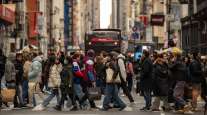Consumer Spending Up in April; Confidence Down in May

Key points from the two reports:
- Consumer purchases climbed 1% in April (versus a 0.7% forecast) after little change in March
- Increase in spending was the biggest since August 2009
- Personal income climbed 0.4% for a second month
- The Fed’s preferred measure of inflation (tied to consumer spending) climbed 0.3% from the month before, the biggest since May 2015; 1.1% from year before
- Consumer confidence index fell to 92.6, the lowest since November, from a revised 94.7 in April; median forecast in a Bloomberg survey of economists was 96.1
- Measure of consumer expectations for the next six months fell to 79, the lowest since February 2014 from 79.7
- Gauge of present conditions dropped to 112.9, also a six-month low, from 117.1
“Consumers remain cautious about the outlook for business and labor market conditions,” Lynn Franco, director of economic indicators at the Conference Board, said in a statement. “Thus, they continue to expect little change in economic activity in the months ahead.”
“The juxtaposition between the robust consumer spending figures and the softer confidence numbers released on the very same day is especially hard to reconcile, but I come down on the side of the spending figures, as it always make sense to follow the actual dollars,” Stephen Stanley, chief economist at Amherst Pierpont Securities LLC in New York, said in a research note.
More details:
- After adjusting for inflation, which generates the figures used to calculate gross domestic product, purchases climbed 0.6% in April, the most since February 2014, after being little changed the prior month
- Purchases of durable goods jumped 2.2%
- Price measure excluding food and fuel increased 0.2% in April from month before and 1.6% in 12 months ended April
- Disposable income (money left over after taxes) increased 0.2% in April from prior month after adjusting for inflation; up 3.3% over past year




